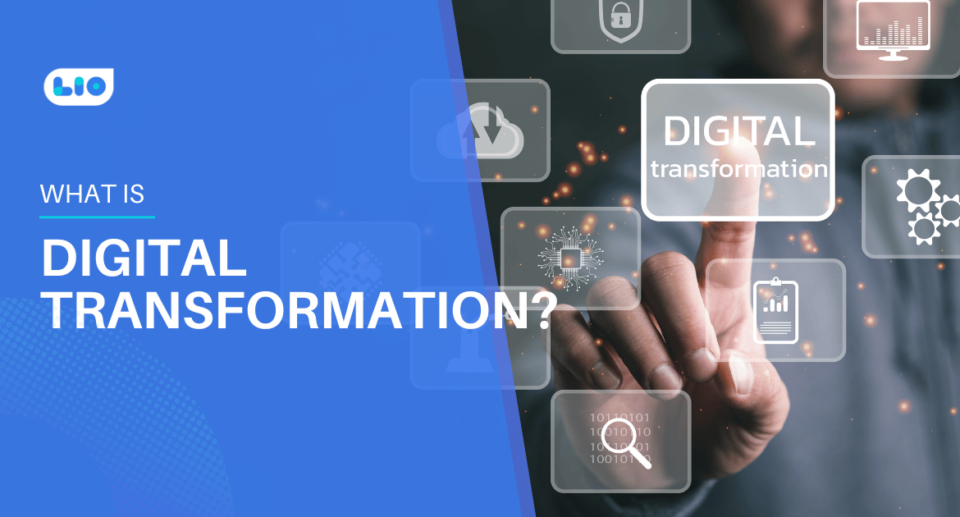What is Digital Transformation?
Gaurav Singh Rawat
- September 2, 2025
- 12 Min Read

In today’s rapidly evolving business landscape, digital transformation has become a critical imperative for enterprises seeking to remain competitive, agile, and customer-centric.
As technology continues to reshape industries and consumer expectations, organizations must embrace digital transformation to unlock new opportunities, streamline operations, and deliver unparalleled value to their customers.
What Is Digital Transformation?
Digital transformation is the process of using digital technologies to fundamentally change how an organization operates and delivers value to customers. It involves integrating digital technology into all areas of a business, resulting in significant changes to corporate culture, business processes, and customer experiences.
Digital transformation goes beyond simply digitizing existing processes. It requires organizations to rethink their entire business strategy to align with the possibilities and opportunities presented by digital technologies. The goal is to build a competitive advantage by continuously deploying technology at scale to improve customer experience and lower costs.
Key Areas of Enterprise Digital Transformation
Successful digital transformation initiatives typically focus on three key areas:

Customer Experience
– Using technology to better understand customers, fuel growth, and create more customer touchpoints.
– Leveraging data analytics and AI to gain deeper insights into customer behavior and preferences, enabling personalized experiences.
– Providing a seamless omnichannel experience across various customer interaction channels.
– Enhancing customer satisfaction and loyalty by delivering exceptional, personalized digital experiences.
Operational Processes
– Improving internal processes by digitizing workflows, automating tasks, and enabling employees with digital tools.
– Using data analytics to make more informed, strategic business decisions.
– Streamlining and optimizing processes like supply chain management for greater efficiency.
– Achieving operational excellence through digital technologies that enhance productivity, reduce inefficiencies, and increase agility.

Digitize for Business Agility
Harness the power of digital technologies to increase agility, adapt to change, and stay ahead of the competition in the digital age.
Business Models
– Transforming the core business model by introducing digital products and services.
– Using technology platforms to provide global shared services and enter new markets.
– Exploring new revenue streams and business models enabled by digital technologies, such as subscriptions, marketplaces, or pay-per-use.
– Innovating and adapting business models to leverage the opportunities presented by digital transformation.
Some other important considerations for a successful enterprise digital transformation include:
– Strong leadership and change management to drive the transformation and get organization-wide buy-in.
– Investing in a robust, scalable technology infrastructure, often leveraging cloud computing.
– Fostering a digital-first, agile culture that encourages innovation and continuous improvement.
– Establishing the right metrics and KPIs to measure the progress and outcomes of digital initiatives.
Enterprise digital transformation requires a holistic approach that reimagines the customer experience, optimizes operations, and transforms business models by strategically leveraging digital technologies. A well-planned digital transformation strategy, strong leadership, and a supportive organizational culture are critical for success.
Key Aspects of Digital Transformation
Integration of Digital Technology
Digital transformation involves the integration of digital technology into all areas of a business, fundamentally altering how businesses operate and deliver value to customers.
It’s not just about upgrading systems but about leveraging technologies such as AI, machine learning, the Internet of Things (IoT), and cloud computing to transform services or products.
Cultural and Organizational Change
A significant part of digital transformation is cultural change. It requires organizations to continually challenge the status quo, experiment, and get comfortable with failure.
This cultural shift is often more challenging than technological changes because it requires a change in mindset and behavior from leadership and employees.
Customer-Centric Approach
At its core, digital transformation is driven by the need to improve customer experience. This involves understanding customer needs more deeply, leveraging data to deliver personalized experiences, and engaging with customers across multiple digital channels.
Operational Agility
Digital transformation fosters an environment of operational agility, allowing businesses to respond quickly to market changes and external pressures, such as those experienced during the COVID-19 pandemic.
This agility is often supported by technologies like cloud computing and advanced analytics, which provide the infrastructure and insights needed to make rapid adjustments.

Accelerate Your Digital Journey
Embrace digital transformation to streamline operations, boost efficiency, and unlock new growth opportunities. Start your journey today!
Continuous Adaptation and Innovation
Unlike traditional business transformations, digital transformation is a continuous adaptation process without a clear endpoint.
As technology evolves, so must the business strategies and operations that rely on it. This ongoing transformation requires a commitment to learning and innovation at all levels of the organization.
Enhanced Decision-Making
With digital transformation, organizations can collect and analyze large amounts of data to make informed decisions.
This data-driven decision-making helps in identifying trends, predicting market changes, and better understanding customer behavior, which can lead to more effective strategies.
Strategic Business Benefits
Successfully implemented, digital transformation can lead to numerous strategic benefits, including increased efficiency, higher customer satisfaction, improved speed to market, and competitive advantages in the digital economy.
It enables businesses to not only improve their current processes but also to innovate new ways of doing business that were not possible before.
What Is the Importance of Digital Transformation?
Digital transformation is crucial for businesses to remain competitive, efficient, and relevant in today’s rapidly evolving digital landscape. Here are some key reasons highlighting the importance of digital transformation:

Staying Competitive
Companies that fail to embrace digital transformation risk falling behind their more adaptable and innovative competitors.
In a fiercely competitive business environment, driving digital transformation is considered essential for any company that intends to stay relevant.
Improving Efficiency and Productivity
Digital technologies can significantly improve a business’s efficiency by automating manual processes, reducing errors, and streamlining operations. This leads to increased productivity, cost savings, and better resource management.
Enhancing Customer Experience
Digital transformation enables companies to better understand and engage with customers across multiple touchpoints, delivering personalized experiences that foster loyalty and growth.
By leveraging data analytics and AI, businesses can gain deeper insights into customer behavior and preferences.

Transform Customer Experiences
Leverage digital transformation to deliver seamless, personalized experiences across all touchpoints and exceed customer expectations.
Driving Innovation
Digital transformation fuels business growth through innovation. It allows companies to create new products, services, and business models, as well as expand into new markets. A culture of innovation and continuous improvement is crucial for businesses to thrive in the digital age.
Increasing Agility and Resilience
Digital technologies make businesses more agile and adaptable, allowing them to respond quickly to changing market conditions and customer needs. This agility is essential for organizations to survive and thrive in the face of disruption.
Empowering Employees
Digital transformation provides employees with the tools and skills they need to work more efficiently and collaboratively. By fostering a digital-first culture and upskilling the workforce, companies can build a more resilient and adaptable team.
Ensuring Long-Term Survival
Without evolving through digital transformation, businesses risk becoming obsolete. Embracing digital technologies is no longer optional but imperative for long-term survival and success.
The Benefits of Digital Transformation
Digital transformation offers numerous benefits to businesses across various industries. Here are some of the key advantages:
Improved Efficiency and Productivity
Digital technologies can streamline operations, automate repetitive tasks, and reduce the time and resources required to complete tasks. This leads to increased efficiency and productivity, allowing employees to focus on higher-value activities.

Enhanced Customer Experience
Digital transformation enables businesses to better understand and engage with customers across multiple touchpoints, delivering personalized experiences that foster loyalty and growth.
By leveraging data analytics and AI, companies can gain deeper insights into customer behavior and preferences, tailoring their products, services, and interactions to meet or exceed expectations.
Increased Agility and Adaptability
Digital technologies make businesses more agile and adaptable, allowing them to respond quickly to changing market conditions and customer needs. This agility is essential for organizations to survive and thrive in the face of disruption.
Data-Driven Decision Making
Digital transformation generates vast amounts of data, which can be analyzed to gain insights into customer behavior, market trends, and operational performance.
This enables businesses to make more informed, data-driven decisions that optimize processes, reduce costs, and drive growth.
New Revenue Streams and Business Models
Digital transformation allows businesses to explore new revenue streams and business models enabled by digital technologies.
This includes introducing digital products and services, leveraging technology platforms to enter new markets, and adopting innovative pricing models such as subscriptions or pay-per-use.
Competitive Advantage
By embracing digital transformation, businesses can differentiate themselves from competitors, offering superior customer experiences, faster time-to-market, and innovative products and services. This competitive edge is crucial for long-term success in today’s digital age.
Examples of Digital Transformation in Different Industries
Digital transformation is revolutionizing industries across the globe, from healthcare and finance to manufacturing and retail. The strategic adoption of digital technologies is enabling organizations to reimagine their operations, enhance customer experiences, and unlock new opportunities for growth and innovation. Here are some examples of digital transformation across various industries:

Digital Transformation in Healthcare
– Adopting telemedicine and mobile health applications to improve patient access and experience
– Leveraging data analytics and AI to personalize treatment plans and predict patient outcomes
– Implementing secure patient portals for convenient access to health information
– Using IoT devices for remote patient monitoring and real-time data collection
– Integrating health coaching software to provide tailored wellness plans and improve patient engagement
– Avoiding common telehealth mistakes that could hinder the effectiveness of these digital tools
Digital Transformation in Manufacturing
– Integrating data across the supply chain, design, engineering, production, and customer service to create a digital thread
– Leveraging IoT sensors for predictive maintenance and optimizing production processes
– Adopting 3D printing and augmented reality for product design and development
– Using data analytics for quality control and to reduce errors and rework
Digital Transformation in Energy and Utilities
– Utilizing data analytics to improve power plant efficiency and optimize transmission networks
– Implementing digital management systems to reduce energy consumption and costs in wastewater treatment
– Using IoT sensors to monitor oil and gas pipelines and improve drilling accuracy
– Engaging customers through social media and digital platforms to promote energy-saving programs
Digital Transformation in Transportation and Logistics
– Implementing real-time vehicle and shipment tracking using IoT sensors
– Optimizing routes and predicting maintenance needs through data analytics
– Adopting autonomous vehicles and drones for delivery and transportation
– Using digital technologies for smart logistics and efficient fleet management
Digital Transformation in Banking and Finance
– Adopting mobile banking applications and digital payment solutions
– Leveraging blockchain technology for secure transactions and record-keeping
– Applying data analytics and AI for personalized financial services and fraud detection
– Implementing digital onboarding and customer support through chatbots and virtual assistants
Digital Transformation in Retail
– Creating omnichannel experiences that integrate online and in-store shopping
– Using data analytics for personalized marketing, product recommendations, and dynamic pricing
– Implementing mobile point-of-sale systems and digital inventory management
– Adopting augmented reality and virtual reality for product visualization and immersive experiences
Frequently Asked Questions (FAQs)
What are the biggest challenges in implementing digital transformation?
Some of the major challenges organizations face in their digital transformation journey include:
– Lack of a clear strategy and roadmap
– Resistance to change and cultural challenges
– Legacy systems and complex technology integrations
– Shortage of digital skills and talent
– Cybersecurity and data privacy concerns
– Inadequate budget and resources
– Difficulty in measuring ROI and progress
Overcoming these challenges requires strong leadership, change management, upskilling of workforce, and a customer-centric, agile approach to transformation.
What are the key technologies enabling digital transformation?
While the specific technologies driving digital transformation can vary by industry, some of the most impactful ones include:
– Cloud computing for scalability, flexibility, and cost efficiency
– Big data and analytics for data-driven insights and decision making
– Artificial Intelligence and Machine Learning for intelligent automation and predictions
– Internet of Things for real-time data and connected ecosystems
– Blockchain for secure, decentralized transactions and record-keeping
– AR/VR for immersive experiences and remote collaboration
– 5G for high-speed connectivity and enabling new use cases
The successful adoption and integration of these technologies, aligned with business goals, is crucial for driving digital transformation forward.
How do you measure the success of digital transformation initiatives?
Measuring the success of digital transformation initiatives is crucial to ensure that investments are delivering the desired outcomes. Some key metrics to consider include:
– Return on Investment (ROI): Comparing the costs of implementing digital technologies against the financial benefits realized, such as increased revenue or cost savings.
– Key Performance Indicators (KPIs): Tracking specific, measurable goals that align with the overall objectives of the digital transformation, such as customer satisfaction scores, employee productivity, or process efficiency.
– Employee Adoption and Engagement: Monitoring how well employees are embracing and utilizing the new digital tools and processes, as this directly impacts the success of the transformation.
– Customer Experience Metrics: Evaluating the impact of digital initiatives on customer satisfaction, loyalty, and advocacy through surveys, Net Promoter Scores (NPS), and customer feedback.
Regularly monitoring and reporting on these metrics helps organizations gauge progress, identify areas for improvement, and demonstrate the value of their digital transformation efforts to stakeholders.
What are some common pitfalls to avoid in digital transformation?
While digital transformation offers significant benefits, there are also several common pitfalls that organizations should be aware of and take steps to avoid. These include:
– Lack of a clear strategy and vision, leading to disjointed initiatives and wasted resources.
– Underestimating the importance of change management and failing to address organizational resistance to new ways of working.
– Focusing too heavily on technology implementation without considering the broader implications for people, processes, and culture.
– Failing to involve key stakeholders, such as frontline employees and customers, in the design and implementation of digital solutions.
– Inadequate data governance and security measures, exposing the organization to risks such as data breaches and regulatory non-compliance.
– Pursuing too many initiatives simultaneously, leading to change fatigue and diluted impact.
– Neglecting to establish clear metrics and monitoring processes to track progress and measure success.
By being mindful of these common pitfalls and taking proactive steps to mitigate them, organizations can increase the likelihood of a successful and sustainable digital transformation.

